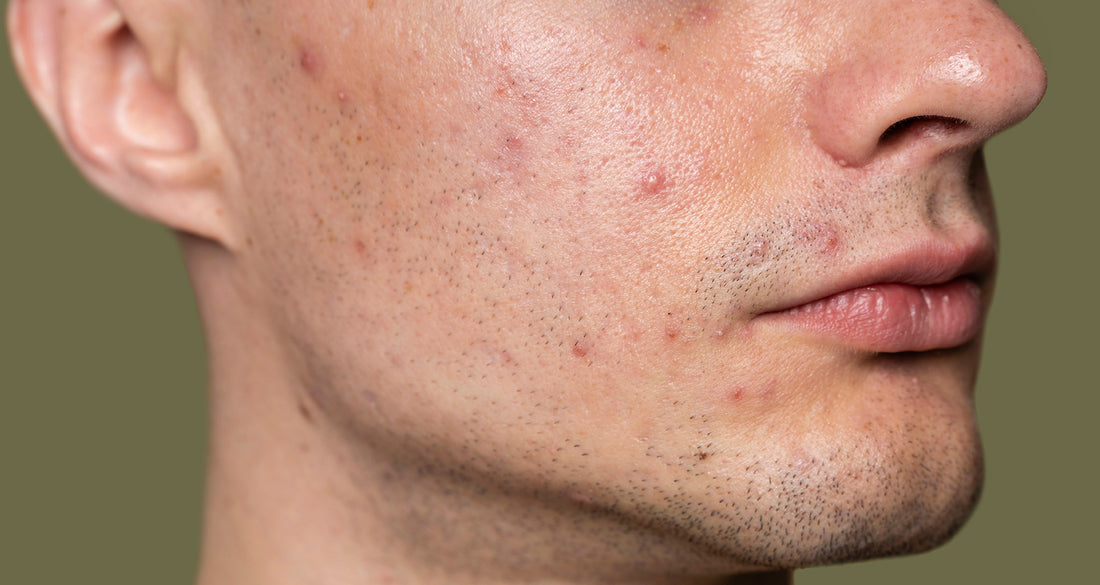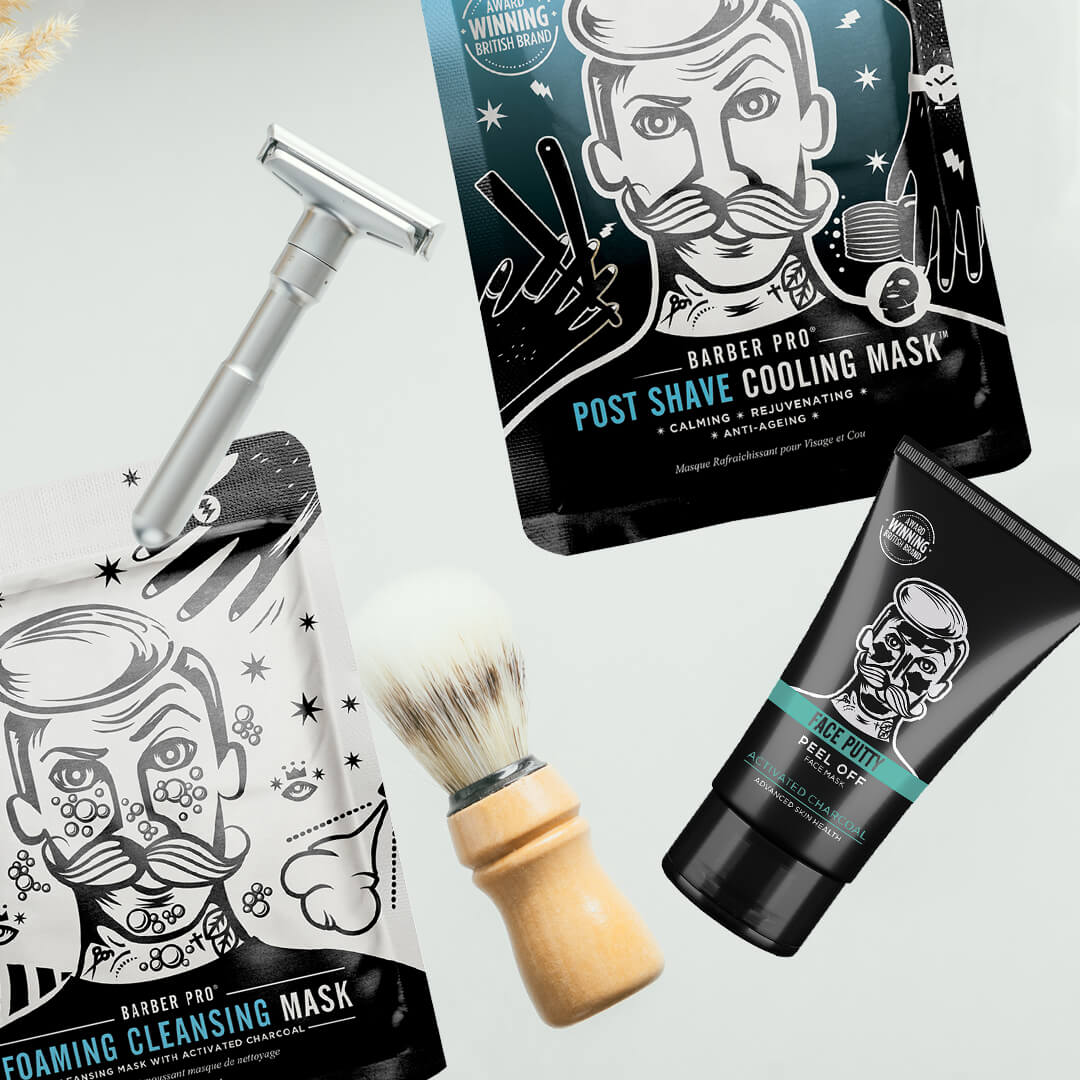
Acne: What is it and how can I reduce it?

Acne is a common skin condition, where spots and oily skin develop on the face, back or chest. While it’s most common on the face, over half of the people with acne will experience it on the back, and a further 15% will be affected in the chest area.
We’re here to discuss facial acne - exploring what it is, why it forms and remedies you can use to soothe the skin and minimize the symptoms.
What is acne?
Acne is an inflammatory skin condition that causes spots, pimples and even cysts. It is a common concern, especially amongst those going through puberty.
It occurs when hair follicles beneath the skin become clogged. This can be caused by oil, dead skin cells and bacteria.
Usually our sebaceous glands release continual and small amounts of oil/sebum into the hair follicles and skin to keep it moisturised and lubricated. Dead skin cells are carried with the sebum to push them out of the body. However, when the gland creates too much sebum, the pores can become blocked. This means that the oil, dead skin cells and bacteria gets trapped in the skin, causing the bacteria to multiply and infect the skin around it. When we experience blockages in our pores, it can cause our sebaceous glands to produce more oil and therefore further blockages. This bacteria and clogged pores then forms into spots, blackheads and other blemishes.
Types of acne
There are 6 types of spots or blemishes caused by acne. These are:
Blackheads - small black or yellowish bumps which are particularly prevalent on the nose and chin. They are dark in colour as you can see the inner lining of the hair follicle which produces colour when it reacts with sebum.
Whiteheads - similarly to blackheads, these are small bumps on the skin, however whiteheads feel firmer and will not empty when squeezed. They occur when the follicles become filled with bacteria. This has no reaction and therefore the colouring stays white.
Papules - small red bumps which can feel sore or tender. These are usually less than 5mm wide and don’t have pus inside them.
Pustules - similar to papules, apart from the presence of pus. These will have a white tip in the centre filled with white, yellow or cream coloured pus. They tend to appear near oil glands.
Nodules - hard, large bumps beneath the surface of the skin that can be painful. These tend to not develop a white head and can last for weeks or months.
Cysts - these are the most severe form of acne spot. Cysts are large pus-filled bumps, that bear a resemblance to boils and have the biggest risk of scarring. These are usually red and painful to the touch.
What is causing me to have acne?
There are many triggers that may cause acne throughout your life. These are:
Testosterone - teenage acne is often caused by increased levels of testosterone which occurs during puberty. It is a hormone and your sebaceous glands are sensitive to hormones, therefore causing them to create more sebum.
It’s inherited - unfortunately, it can just run in the family. If your parents had it, you’re likely to develop it too.
You’re using the wrong cosmetic products - some products could cause your pores to block. Make sure you look out for non-comedogenic formulas to prevent spots.
Some medication - steroid medicines, lithium and some epilepsy drugs can cause acne
Smoking - just another point to pop onto the ‘I need to stop smoking’ list!
Materials are often rubbing on the affected area - masks, headbands etc can all be responsible for causing skin flare ups as they trap the bacteria in the skin.
Obviously not all of the above can be helped, but it’s good to have an understanding of what may be causing your breakouts so that you know how to manage and prevent it in the future.
Acne can’t be cured, however it can be managed by treatment.
How can I treat my acne?
Treatment for acne depends on the severity of the condition. If you have severe acne, we’d recommend visiting a doctor to create a suitable treatment plan.
You should bear in mind that it can take several months of continuous treatment before you’ll see improvements.
As long as an acne product isn’t making the problem worse, you should stick to it and expect to see improvements in 4-6 weeks. Avoid using different products regularly, as you could actually be making the condition worse. Stick to one treatment and wait to see the results.
Wash your face twice a day and after exercise or sweating.
This is important to flush away any bacteria or oils that could be blocking your pores. While it might be tempting to wash your face more than this, that could actually irritate your skin even further and make the acne worse. Try to stick to washing when you wake up, before you go to bed and after exercise.
You should also wash your face gently. Though it might be tempting to scrub it, this could anger the skin more. Pat product into the skin and gently wipe away dirt.
Choose the right products
It might seem counterintuitive, but sometimes your cleansing products could be what’s causing your skin to react. When shopping for skincare or cosmetic products, check the labels and ensure you are purchasing non-comedogenic, non-acnegenic, oil free products that won’t clog the pores.
No touching, picking or popping!
We’ve all been there, you wake up to a massive zit and there’s nothing more tempting than popping it. However, while this might seem like the fastest way to be rid of it, it will actually make it worse.
Every time you touch your skin or acne, you’re transferring bacteria from your hands to your face. More bacteria is the last thing your acne needs. By popping the spot, you’re opening the wound making it even easier for the bacteria to travel in.
Plus once you’ve broken the skin it’s more likely to bleed, scab or scar - none of which we want!
Regularly wash any fabrics that touch your skin
Pillowcases, hats and face masks build up dead skin cells, bacteria and dirt the more you use them. Again, we need to keep this way from our skin. Regularly washing these fabrics can help to limit the amount of bacteria your skin is exposed to.
Try taking a zinc supplement
Those who suffer with acne, often have lower levels of zinc in their blood than people who have clear skin. Zinc is vital for cell growth, hormone production, metabolism and immune function - and therefore could benefit those who have acne when it comes to tackling outbreaks.
Use Tea Tree to fight bacteria and inflammation
Tea tree oil is a popular skin care ingredient thanks to its anti-inflammatory properties. It can also help to relieve dry or irritated skin. Many studies have found that applying it topically may reduce acne.
3 of our BARBER PRO masks contain Tea Tree:
Face Putty Peel Off Mask - a deeply cleansing solution that detoxifies skin well below the surface. Shop now >>
Post Shave Cooling Mask - an intensely hydrating and soothing mask that reduces irritation and calms the skin. Shop now >>
Foaming Cleansing Mask - a gentle cleansing mask that micromassages the skin to purify the pores and target blackheads. Shop now >>
Utilise Green Tea antioxidants
Similarly to Tea Tree, Green tea will also help to reduce inflammation and tackle bacteria. The main antioxidant present in the ingredient has been shown to reduce the production of sebum and inhibit the growth of acne.
The BARBER PRO Gentlemen’s Sheet Mask contains Green Tea and in just 15 minutes it will use the powerful antioxidant and antibacterial properties of Green Tea to reduce redness, protect from free radicals and ensure the area is moisturised. Shop now >>
Apply Witch Hazel
Another key ingredient with antibacterial and anti-inflammatory properties is Witch Hazel. It’s extracted from the leaves and bark of a North American shrub and is used to treat a wide range of conditions such as eczema, dandruff, burns, bruises and insect bites, as well as acne.
Research suggests it helps to reduce bacteria and soothe inflammation and irritation of the skin.
3 of our BARBER PRO masks contain Witch Hazel:
Post Shave Cooling Mask >> Shop Now
Gentlemen’s Sheet Mask >> Shop Now
Foaming Cleansing Mask >> Shop Now
Ensure you skin is moisturised with Aloe Vera
Aloe Vera is commonly used in many skincare products. The clear gel is used to treat rashes, burns and other skin irritation as it can help to heal wounds and soothe inflammation. Aloe Vera also contains salicylic acid which is used extensively in the treatment of acne.
The BARBER PRO Post Shave Cooling Mask contains Aloe Vera and powerfully nourishes and calms the skin. Shop now >>
Regularly exfoliate
As acne can be caused by pores being clogged by dead skin cells, it’s important to remove these cells before they cause a blockage. This can be done by regularly exfoliating the skin and removing the top layer of dead cells.
The BARBER PRO Face Putty Peel Off Mask exfoliates the skin to leave it fresh and healthy. The Activated Charcoal in the formula pulls bacteria from the skin, detoxifying the pores, while also removing the outer layer of dead skin cells. Shop now >>

